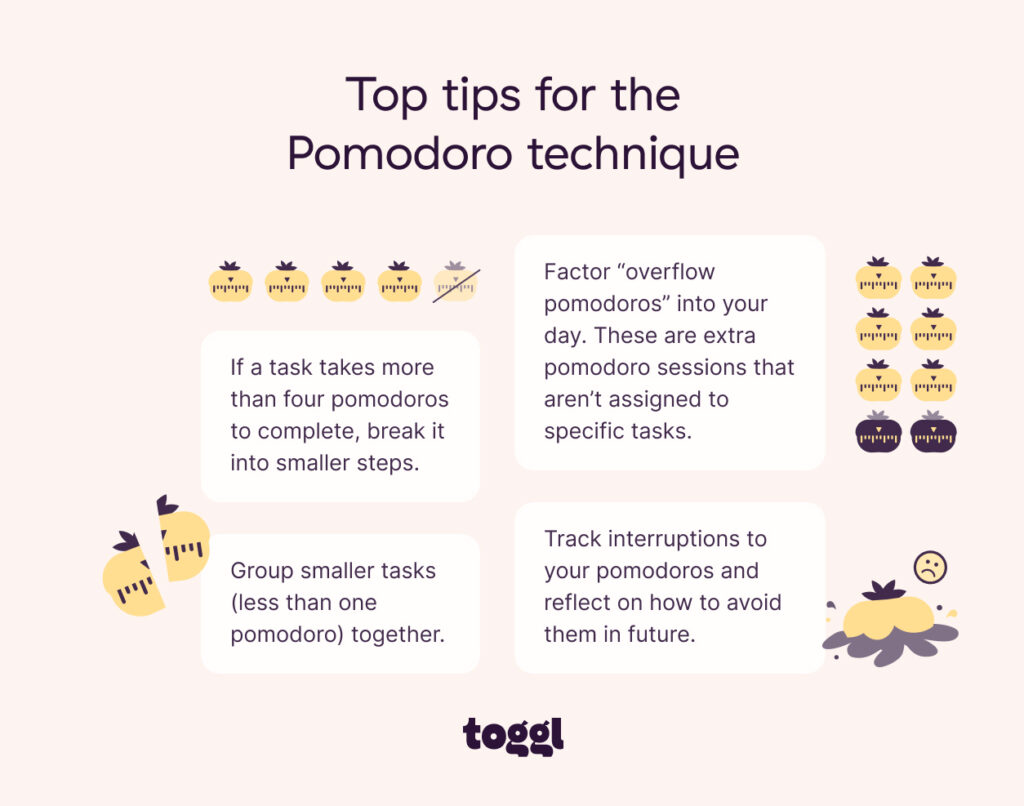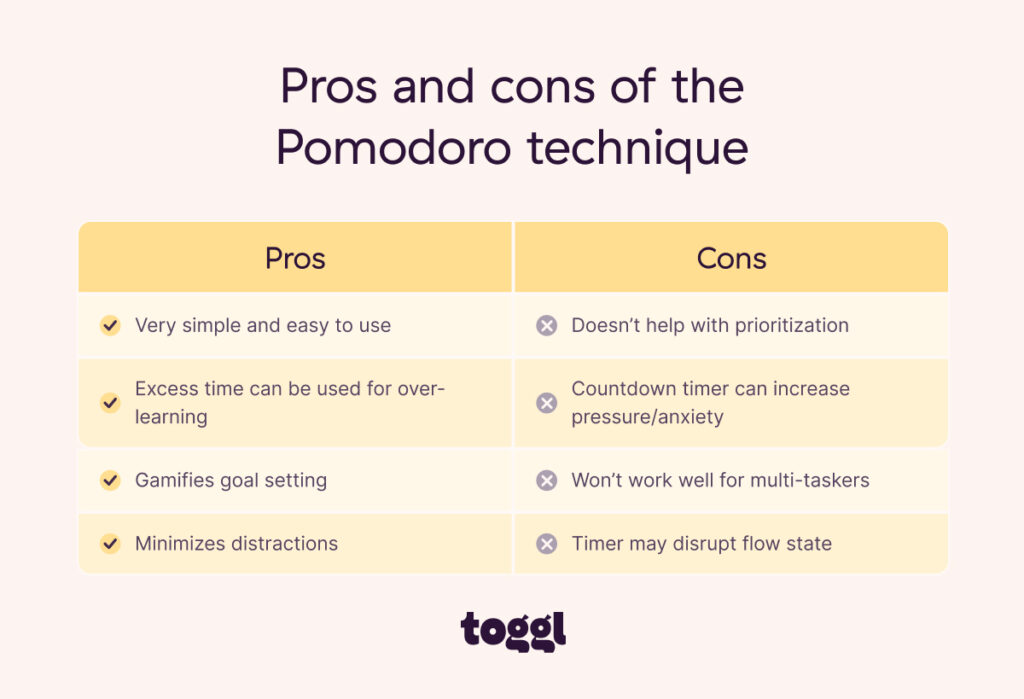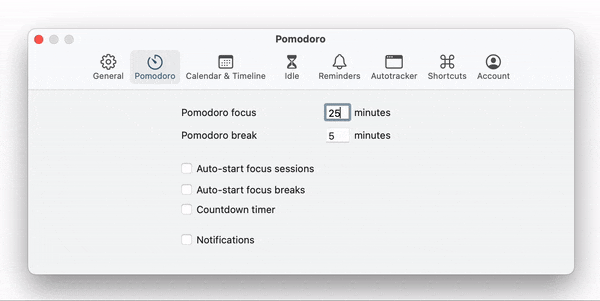It’s hard not to get swept up in the mania of productivity hacks.
My Instagram and X (and with a heavy heart, now my LinkedIn) feeds are full of people recommending an “app of the week” to get more done. Or, it’s people waking up at 3 am to have ice baths. Telling me to buy this book, or that desk accessory.
To be honest, I’ve never been convinced any of this stuff actually works.
The most I’ve done to improve productivity and focus is install a website blocker (and I always manage to find a way around it if I want to.)
So, when I was tasked with writing this article about The Pomodoro Technique, I was skeptical.
Can a timer really help you be more productive? And more importantly, how well does a productivity technique from the 1980s stand up to the daily demands of modern work?
Here are my thoughts on The Pomodoro Technique and how it stacked up. 👇
The Nuts and Bolts of The Pomodoro Technique
Before we talk about how The Pomodoro Technique works, let’s take a quick walk down memory lane.
It all started with an Italian university student named Francesco Cirillo. In the 1980s, when working on a project in his kitchen, he noticed a tomato-shaped timer near him (which I think is very 80s). Francesco decided to set the timer and use it as a target to stay focused — and reward himself with a break when it went off.
This is when The Pomodoro Technique was born. Crillo shared the technique with classmates (who also started to use it), before running Pomodoro workshops and seminars around in the 1990s. He even wrote a book about it.
The reason Crillo’s technique is still so popular with productivity hackers may be down to how easy it is to use. Here’s how Pomodoro works:
- Set a timer for 25 minutes
- Focus on a single task and work on it until the timer rings
- When the 25 minutes is up, take a (well-earned) five-minute break
- Mark on a chart that you’ve completed “one Pomodoro”
- Once you complete four Pomodoros, take a 30-minute break to recharge your 🧠
No need for fancy tools, over-complicated spreadsheets, or an ice bath. Just grab your kitchen timer — and get productive.
What Makes The Pomodoro Technique Unique
The beauty of the Pomodoro Technique isn’t just its stop/start/reward structure — it’s the underlying principles behind it. Each 25-minute block (or Pomodoro) is essentially a very focused work sprint.
To get the most out of Pomodoro, it takes preparation:

For example, some Pomodoro productivity gurus swear by batching small tasks. If you need to tackle work emails, answer Slack messages and reply to LinkedIn comments, don’t set individual Pomodoros for each task. Batch “similar” tasks together and tackle them in the same Pomodoro block to maximize productivity.
Others say blocking internet sites or breaking tasks down into smaller pieces is the way to win with Pomodoro.
Obviously, the breakdown of workflows will look different depending on your tasks. A writer’s to-do list will look different to a software developer. But the principle behind Pomodoro is the same: with regular, focused blocks of work, you can get more done.
I think the best way to figure out if The Pomodoro Technique is a good fit is to put the method to a real-life test. But before we do, let’s look at all the pros and cons. 👇
Pros and Cons of The Pomodoro Technique

The Pomodoro Technique has barely changed since Cirillo invented it in his kitchen over 40 years ago. A lot of the pros are still the same: it’s super easy to use, it cuts out distractions, and it gamifies goal setting.
However, using Pomodoro also comes with some cons. Not only can it interrupt productive workflows, but it also isn’t a good fit for team collaboration. Chris Chung is an avid Pomodoro user and thinks, after five years of using the technique, it’s best for working solo.
“In terms of mental investment, interruptions are expensive. After an interruption, it may take you several minutes to get back to where you were. When you can genuinely unplug your mind from the steam of office communication and wall yourself off from people who want to tap you on the shoulder, that’s when the Pomodoro Technique truly shines. If no one can interrupt you, you can get full benefit from highly focused work.”
Even when you work on a task solo, Pomodoro is designed for smaller chunks of work—something that squeezes into a 25-minute window. As Mike Vardy points out, the rigidity of the 25-minute productivity block not only forces you to step away, but it also prompts you to move on to another task.
“So, when you start your day (or take the time on the day before to plan your day), you need to work out “Pomodoros” with the knowledge that you have 25 minutes or less to work on it at any given time. I’m not a fan of systems that are that rigid.”
All these pros and cons got me thinking… is Pomodoro even fit for the modern worker, or is it time for a change? 🤔
Is It Time to Tweak The Pomodoro Technique?
Admittedly, I’ve never used Pomodoro before. So, I decided to test it out during the research, writing, and editing stages of producing this article.
What I found… may not be welcomed by Pomodoro fanatics 🙃
I started the test by ticking off the “basic” Pomodoro hacks everyone talks about online:
📵 No phone. My iPhone was put into silent mode. No phone calls or Slack messages allowed
❌ No multitasking. I focused on one part of my process (either researching, writing a section of the article, or editing)
🗑️ Decluttering. I cleared all of the clutter off my desk (like the coffee cups and notebooks I was hoarding)
🧘 Clearing my mind. I began every Pomodoro by closing my eyes and taking a couple of deep breaths to focus my brain
So, did I quickly turn into a writing machine? 🤔
Not exactly.
My first problem was the 25-minute productivity block. On paper, it seems like a fair chunk of time. But when I hit a writing stride and started to pump out some serious words, the timer felt like the equivalent of somebody throwing my keyboard out the window.
Then there was the five-minute break. It didn’t feel like enough time for me to do anything. I could catch a breather, scroll X, or make a coffee — but that was it. I started to feel resentful towards the break as it felt like a crappy trade-off for killing my writing vibe. ✍️
It made me wonder if I was the only person who felt like this about Pomodoro. It turns out, I wasn’t. Some of my fellow Redditors over on r/productivity also had similar thoughts:
While some people were done trying to make Pomodoro work, others highlighted specific problems with the traditional technique:
- The timer goes off just as you enter a state of productive workflow, meaning the (really great) work you were about to tackle has been blocked
- Productivity doesn’t fall into a neat little box. Sometimes, it’s impossible to force your brain to concentrate or be creative. But Pomodoro only recognizes work, not thoughts and ideas
This wasn’t enough for me to write off Pomodoro completely. I researched the corners of Reddit, Quota, X and productivity blogs to find a way to tweak Pomodoro so it worked for me.
Here’s what I came up with. 👇
Increase the Length of Each Pomodoro ⏳
My biggest problem with Pomodoro was it didn’t give me enough time to get into a proper work groove. I decided to double both the working time and break time so instead of it being 25/5, it would be 50/10.
This was a game-changer. Although technically my “Pomodoro” count was less on paper, I was getting way more done each time I turned my timer on. I was able to settle into deep work mode without the timer blocking my flow.
Make Pomodoro Breaks Boring 🥱
This tweak took me a minute to figure out.
When my Pomodoro timer went off, I felt like I had to be making the absolute most of those five minutes. I was checking Slack, making a fresh cup of coffee, and religiously checking my LinkedIn feed. But when the five-minute break was up (which I swear only lasted for five seconds), it took me a lot longer to settle back into the Pomodoro block.
To change this, I took a note out of Author Ian Fleming’s book and used the rule of forced boredom.

Fleming’s method gave him two choices while working on a novel: He would either write, or do nothing.
In his breaks, he didn’t read. He didn’t go for a walk, go out for coffee, or meet friends. He did nothing.
So, I copied his technique.
I made my Pomodoro breaks boring as hell. I didn’t go on Slack or check my email. I didn’t make coffee or eat lunch. I just soaked up the view out of my office window. When it was time to restart my Pomodoro timer — it was a lot easier to dive back into deep work.
Watch Your Daily Pomodoro Intake 🍅
I learnt not to cram too many Pomodoros into each day.
You may be different, but I thought I was some kind of tomato-crushing superhero at the start of the Pomodoro experiment — attempting 12+ in one day. This daily intake of Pomodoros is not sustainable. If you try to squash this many focused blocks of work into one sitting, it can lower the quality output of your work because it fries your brain.
My advice?
Start small — think four or five Pomodoros — and see how much work your brain can handle. This allows you to focus on the quality of work inside each Pomodoro block instead of pure output.
Use a Digital Pomodoro Timer ⏲️
Like most of you, I don’t have a tomato timer in my kitchen. But I do have my trusty skiing penguin timer.

But, he’s a little unreliable. He doesn’t always go off when his timer hits zero, and sometimes he freezes at the 12-minute mark.
Not a problem for cooking (usually!). But it’s a big problem for Pomodoro productivity.
I decided to test out a more reliable tool — Toggl Track’s built-in Pomodoro Timer — and the digital version actually helped me focus. First, I set custom Pomodoro focus blocks and breaks based on my 50/10 preference:

Then, instead of watching my penguin tick away, I tucked the digital Pomodoro timer away as a browser extension. I just pressed start session on the timer, and forgot about it until it pinged.

The proof that it worked?
I wrote this whole piece using The Pomodoro Technique — the newer, improved version. 🤌
Just don’t tell Francesco, capire?
Kimberlee is the Content Marketing Manager at Toggl.


